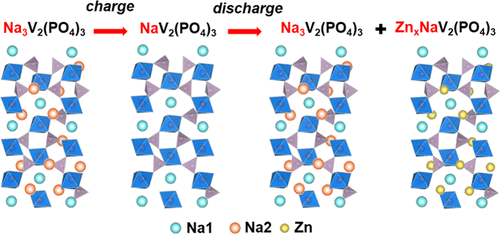当前位置:
X-MOL 学术
›
Chem. Mater.
›
论文详情
Our official English website, www.x-mol.net, welcomes your
feedback! (Note: you will need to create a separate account there.)
NASICON Na3V2(PO4)3 Enables Quasi-Two-Stage Na+ and Zn2+ Intercalation for Multivalent Zinc Batteries
Chemistry of Materials ( IF 7.2 ) Pub Date : 2020-03-11 , DOI: 10.1021/acs.chemmater.0c00004 Jesse S. Ko 1 , Partha P. Paul 1 , Gang Wan 1 , Natalie Seitzman 2, 3 , Ryan Henry DeBlock 4 , Bruce S. Dunn 4 , Michael F. Toney 1 , Johanna Nelson Weker 1
Chemistry of Materials ( IF 7.2 ) Pub Date : 2020-03-11 , DOI: 10.1021/acs.chemmater.0c00004 Jesse S. Ko 1 , Partha P. Paul 1 , Gang Wan 1 , Natalie Seitzman 2, 3 , Ryan Henry DeBlock 4 , Bruce S. Dunn 4 , Michael F. Toney 1 , Johanna Nelson Weker 1
Affiliation

|
Identifying positive electrode materials capable of reversible multivalent electrochemistry in electrolytes containing divalent ions such as Mg2+, Ca2+, and Zn2+ at high operating potentials remains an ongoing challenge in “beyond lithium-ion” research. Herein, we explore the Zn2+ charge-storage mechanism of a vanadium-based Na+ superionic conductor (NASICON), Na3V2(PO4)3. By using X-ray synchrotron techniques to unravel potential-dependent structure–property relationships, we ascribe the reversible electrochemical behavior of Na3V2(PO4)3 to a quasi-two-stage intercalation process that involves both Na+ and Zn2+. Initial charging of Na3V2(PO4)3 leads to a Na+-extracted phase corresponding to NaV2(PO4)3, whereas subsequent discharge results predominantly in Na+ intercalation followed by Zn2+ intercalation. Operando X-ray diffraction of Na3V2(PO4)3 was used to study the phase changes associated with the first charge/discharge process, and ex situ measurements were used to precisely link the changes in the crystal structure to a quasi-two-stage intercalation of Na+ and Zn2+. The corresponding changes in the V-oxidation state, V-O coordination, and the presence of Zn2+ were confirmed by X-ray absorption spectroscopy. The results of this work present a comprehensive understanding of the charge-storage properties for a well-established NASICON structure that confers both the high capacity (∼100 mA h g–1) and high potential (1.35 and 1.1 V vs Zn/Zn2+).
中文翻译:

NASICON Na 3 V 2(PO 4)3使多价锌电池能够准两阶段插入Na +和Zn 2+
在“超越锂离子”的研究中,如何在含有二价离子(例如Mg 2 +,Ca 2+和Zn 2+)的电解质中鉴定出具有可逆多价电化学作用的正极材料仍然是一项持续的挑战。在本文中,我们探讨了钒基Na +超离子导体(NASICON),Na 3 V 2(PO 4)3的Zn 2+电荷存储机理。通过使用X射线同步加速器技术揭示电位依赖的结构-性质关系,我们将Na 3 V 2(PO 43)涉及Na +和Zn 2+的准两阶段插入过程。Na 3 V 2(PO 4)3的初始充电导致对应于NaV 2(PO 4)3的Na +萃取相,而随后的放电主要产生于Na +嵌入,接着是Zn 2+嵌入。Na 3 V 2(PO 4)3的Operando X射线衍射用来研究与第一次充电/放电过程有关的相变,并利用非原位测量将晶体结构的改变与Na +和Zn 2+的准两阶段嵌入精确联系起来。通过X射线吸收光谱确认了V-氧化态,VO配位和Zn 2+的存在的相应变化。这项工作的结果提供了对完善的NASICON结构的电荷存储特性的全面理解,该结构具有高容量(〜100 mA hg –1)和高电势(相对于Zn / Zn 2+的1.35和1.1 V))。
更新日期:2020-04-23
中文翻译:

NASICON Na 3 V 2(PO 4)3使多价锌电池能够准两阶段插入Na +和Zn 2+
在“超越锂离子”的研究中,如何在含有二价离子(例如Mg 2 +,Ca 2+和Zn 2+)的电解质中鉴定出具有可逆多价电化学作用的正极材料仍然是一项持续的挑战。在本文中,我们探讨了钒基Na +超离子导体(NASICON),Na 3 V 2(PO 4)3的Zn 2+电荷存储机理。通过使用X射线同步加速器技术揭示电位依赖的结构-性质关系,我们将Na 3 V 2(PO 43)涉及Na +和Zn 2+的准两阶段插入过程。Na 3 V 2(PO 4)3的初始充电导致对应于NaV 2(PO 4)3的Na +萃取相,而随后的放电主要产生于Na +嵌入,接着是Zn 2+嵌入。Na 3 V 2(PO 4)3的Operando X射线衍射用来研究与第一次充电/放电过程有关的相变,并利用非原位测量将晶体结构的改变与Na +和Zn 2+的准两阶段嵌入精确联系起来。通过X射线吸收光谱确认了V-氧化态,VO配位和Zn 2+的存在的相应变化。这项工作的结果提供了对完善的NASICON结构的电荷存储特性的全面理解,该结构具有高容量(〜100 mA hg –1)和高电势(相对于Zn / Zn 2+的1.35和1.1 V))。





















































 京公网安备 11010802027423号
京公网安备 11010802027423号